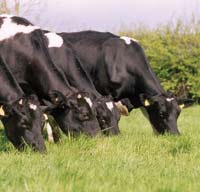Magnesium supplements can prevent staggers

Proactive health management will be crucial in preventing hypomagnesaemia this spring, as recent changeable weather means dairy and beef cattle could be at risk, according to Dallas Keith’s Chris Willett.
“With a lack of sun last year and a hard winter, forage is going to be down in feed value and stocks are unlikely to be in peak condition,” he says.
And according to WestPoint vet Alex Walters the inclement weather means there has been a rise in cases. “Although spring turnout is normally the high–risk period for dairy cows as the lush, fast growing grass lacks magnesium, it is the beef cows that are at more risk because of the weather.”
Anything limiting intake, like snow or frost cover, ultimately affects magnesium intake, according to Mr Walters. “The ability of cows and sheep to mobilise magnesium is poor as they have no stores, so it’s important animals have a constant supply in their diet,” he says.
“When you start seeing symptoms of staggers in one cow it often means there are a number of animals sub-clinically affected. It’s important to act quickly as the time period of the disease can be variable and so it is crucial magnesium deficiency is factored in to a farm health planning protocol,” he says.
But although most spring calving dairy cows will be supplemented with concentrates to get cows back in calf, there is still a possibility cows out on grass can get staggers, says Cheshire vet Neil Howie.
“In cold damp conditions grass can actually inflame the gut resulting in a rapid throughput meaning the absorption of magnesium along with other nutrients is poor. Often scouring is associated with this rapid throughput, so if you see this it is important to add more fibre into the diet to slow down the digestive process and help prevent deficiencies,” he says.
“Although staggers is most commonly associated with spring turnout, it can also occur in the autumn and it’s important to make sure a cow giving 20 litres a day receives at least 30g a day of magnesium, increasing as yield increases,” he says.
Prevention is always better than cure and supplementation is the best way to ensure cows don’t become deficient in magnesium according to Tiverton vet Andy Biggs.
“Magnesium supplementation ranges from adding a magnesium chloride bag into the water and using licks to more sophisticated magnesium salts plumbed into the water valve and also boluses. But you can’t just raise levels to protect because of their inability to store magnesium,” he says.
Mr Biggs recommends adding magnesium supplements to the diet just before turning out. “It’s important to manage how much you are giving and also not to forget dry cows and yearlings,” he says.
“Neurological signs are a key component of staggers, but symptoms also include apprehensions, tremors and twitches and abnormalities in gait and epileptic type fit, before the animal goes down,” says Mr Biggs.
But you have got to be quick at identifying and treating, warns Mr Howie. “Magnesium should never be given in to the vein as it will kill the animal, it should be given subcutaneously,” he adds.
